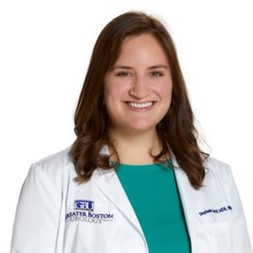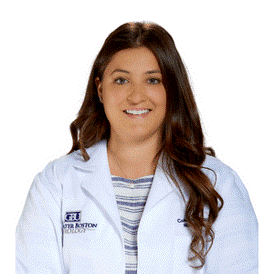If you've ever heard medical providers talk about their collaborative approach to medicine, you might have wondered what they meant.
It's not at all uncommon for medical colleagues to work together when providing patient care. And this is most certainly true when you visit our Women's Health Center in Dedham.
Dr. Angel Marie Johnson serves as the director of the Center, and she works closely with Stephanie Larrick, our women's health nurse practitioner in Dedham.


Below, we discuss their collaborative approach, including how it benefits patients and what patients can expect.
A collaborative approach means more comprehensive care for patients.
Dr. Johnson's schedule is limited since she's in the operating room at least twice a week. But Stephanie is in the office five days a week. So, if a patient phones the Care Center with a medical question, chances are good that Stephanie will field the call.
Dr. Johnson says, "Stephanie is very well-trained and can answer most patients' questions. She runs all answers by me, and in the case of an emergency, she will contact me even if I am in surgery. I'm always aware of what she discusses with patients. Even when she talks to a patient by phone, she always sends me a note about the call. When she sees any patients in the office, I sign off on every clinical visit."
Dr. Johnson says that she carefully reviews Stephanie's orders. If Dr. Johnson has a question, she'll speak to Stephanie directly. If Dr. Johnson believes additional or different orders are necessary, this will prompt a follow-up conversation or visit with the patient. Dr. Johnson says if a patient receives a call from Stephanie with an adjustment to the treatment plan, it's because Dr. Johnson has decided it's necessary.
"If a patient gets a call and hears, 'Oh, we've changed the plan, or we need an extra blood test,' it's important that the patient understands this is because of my review of the patient's clinical visit. Stephanie and I are a team. I'm always aware of what she does and communicates to a patient. And if she calls a patient with updated recommendations, she's speaking on my behalf—it's me talking, not her."
What comes under Dr. Johnson's purview, and what comes under Stephanie's?
After Dr. Johnson sees patients, Stephanie will often take the lead on follow-up visits, especially for non-surgical conditions.
"For example, conditions like urinary tract infections—those patients need to see me first for the testing, the ultrasound, the cystoscopy, the exam," Dr. Johnson explains. "But when it comes to the follow-up visits to discuss whether treatments like cranberry supplements and D-mannose are working, those visits are perfectly appropriate for Stephanie to oversee. Only if something's not working, or the patient feels their condition has changed, do they really need to see me."
And again, because Stephanie is in the office five days a week, she has much more availability in her schedule. So, if a patient wakes up and their pelvic health condition is flaring whatever that may be, they can call the office for a same-day visit and get added to Stephanie's schedule.
"If I'm in the office," Dr. Johnson says, "and if there's something concerning, I can always pop in for the exam or provide my opinion. But Stephanie is a great person to see for those less complex 'sick visits' that can crop up when it comes to a patient's pelvic health."
Dr. Johnson adds, "With my schedule, I rarely have space. I can make space by double booking; however, that comes at a cost and may impact my timeliness. But Stephanie always has space, so getting on her schedule is much easier. Again, if there's something odd, she'll just pop into my office or catch me between patients, and we can treat the condition together."
Which procedures does Stephanie handle?
Dr. Johnson says every doctor is different when it comes to what procedures they have their nurse practitioners or physician assistants perform.
In Dr. Johnson's practice, Stephanie handles the following:
- Pessary cleanings & management. The patient would see Stephanie every three months to have their pessary cleaned, removed, and replaced.
- Estring exchanges. Estrogen rings help treat vaginal atrophy. If a patient doesn't feel comfortable exchanging the estrogen ring, they'll see Stephanie every three months. Stephanie will take out the expired ring and place a new one.
- Urodynamic testing. Urodynamic testing is an objective test of bladder function. Stephanie conducts the urodynamic test, and Dr. Johnson interprets the results. This test allows Dr. Johnson to tailor treatment for a patient's specific condition. Learn how urodynamic testing works.
- Follow up visits after bladder Botox and Bulkamid procedures. Dr. Johnson performs the procedures, and patients follow up with Stephanie two weeks later to discuss the results and to schedule a repeat procedure if needed. Dr. Johnson adds, "Botox for example, is repeated every six months. After the procedure, Stephanie will see the patient and exclude UTI and confirm that the patient can empty their bladder normally. Then, the patient will see me in six months to repeat their bladder Botox."
- Nerve-test follow-up in preparation for an Axonics implant. Dr. Johnson explains, "When I do an office nerve test called a percutaneous nerve evaluation or PNE, patients will follow up with Stephanie in three to five days to remove the wires and then schedule a full Axonics implant with me if they passed the test."
How does Greater Boston Urology's OAB nurse navigator fit into this collaboration?
At GBU, we have an OAB nurse navigator on staff. Her name is Celeste Pires (pictured below), and she helps patients manage their overactive bladder (OAB) treatment plans.

Dr. Johnson says Celeste is an excellent resource to patients because she ensures people stay on track with their follow-up appointments. "We know that when we give a patient a medicine," Dr. Johnson explains, "60% will stop that medicine within one year, and up to 40% never return for follow-up care. Those patients, either men or women, remain untreated, thus suffering with their overactive bladder."
Celeste ensures all OAB patients receive follow-up calls and are invited back into the practice to see their doctor. Various treatment options exist for overactive bladder, so if one treatment doesn't work, there are many other options. But that involves the patients coming back for another visit.
"Celeste helps improve outcomes when it comes to overactive bladder," Dr. Johnson says, "and to get more and more people treated."
Would you like to make an appointment at our Women's Health Center in Dedham?
Request an appointment with Dr. Johnson or Stephanie.
More helpful reading:
